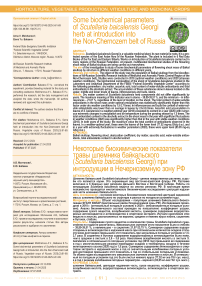Some biochemical parameters of Scutellaria baicalensis Georgi herb at introduction into the Non-Chernozem belt of Russia
Автор: Molchanova A.V., Babaeva E.Yu.
Журнал: Овощи России @vegetables
Рубрика: Садоводство, овощеводство, виноградарство и лекарственные культуры
Статья в выпуске: 3 (83), 2025 года.
Бесплатный доступ
Relevance. Scutellaria baicalensis Georgi is a valuable medicinal plant, its raw material is roots. It is a protected species of the East Asian flora of the Russian Federation. The plant is included in 6 Red Data Books of the Far East and Eastern Siberia. Works on introduction of Scutellaria baicalensis carried out in many regions of the Russian Federation. At present, multifaceted biochemical studies of the flowering shoot mass of Baikal skullcap are being carried out everywhere. The aim of the investigation is study of some biochemical parameters of flowering shoot mass of Baikal skullcap by structure in different weather conditions in different years. Materials and methods. The object of the study was the population of Baikal skullcap from the biocollections of All-Russian Scientific Research Institute of Medicinal and Aromatic Plants (Central Region of the Non-Chernozem belt). Studies were conducted in 2018 (optimal weather conditions) and 2020 (stresses weather conditions). The biochemical composition of the shoot of Scutellaria baicalensis studied in the Laboratory and Analytical Department of the FSBSI “Federal Scientific Vegetable Center” according to the following parameters: dry matter, ascorbic acid, total content of water-soluble antioxidants and total antioxidants in the alcoholic extract. The accumulation of these substances done in leaves located on the upper, middle and lower levels of leaves, inflorescences and buds, stems. Results. Dry matter content of Scutellaria baicalensis herb components did not differ significantly by years. The maximum meaning of this indicator was in stems – 38.89-39.51 %, and the minimum – in inflorescences – 21.07 %, regardless of the level of location on the shoot. The total content of water-soluble antioxidants in the shoot mass under optimal precipitation was statistically significantly higher than this factor under dry weather conditions by 1.5-2.7 times. In inflorescences and buds the content of water-soluble antioxidants was lower than on average in leaves by 2.6-3.6 times. Ascorbic acid accumulation in leaves of S. baicalensis in a weather-optimal year (2018) exceeded its content in a year (2020) with numerous extremely changes in precipitation and air temperature during the growing season by 1.5 times. The total antioxidant content in the alcoholic extract in the shoot mass in the year with significant fluctuations in weather conditions (2020) was significantly higher than that in the year with stable weather conditions (2018). In both years of the study, the maximum value the total content of antioxidants observed in the leaves. In a weather-optimal year, these were the leaves of the lower level (77.52 mg-eq GA/g d.w.), and in a year with extremely fluctuations in weather parameters (2020), these were upper level (83.05 mg-eq GA/g d.w.).
Baikal skullcap, flowering shoot, desiccation coefficient, dry matter, ascorbic acid, water-soluble antioxidants, total antioxidants content in alcohol extract
Короткий адрес: https://sciup.org/140310386
IDR: 140310386 | УДК: 633.88:581.19(470.31) | DOI: 10.18619/2072-9146-2025-3-61-69


